OPENING RECEPTION:
FRIDAY, OCTOBER 25, 2024
6 TO 9 PM
‘By the late twentieth century, our time, a mythic time, we are all chimeras, theorised and fabricated hybrids of machine and organism—in short, cyborgs.’
—Donna Haraway, A Cyborg Manifesto
Christiane Peschek was born in 1984, less than a year before Donna Haraway’s A Cyborg Manifesto was published. It’s a loose coincidence that might have gone unobserved if it wasn’t for the emergency cardiac surgery Peschek underwent a few months ago. Waking up with an ICD implant in her chest to regulate her heartbeat, Peschek realised that she was now the epitome of the chimera that Haraway had imagined, a fabricated hybrid of machine and organism—in short, a cyborg.
In Haraway’s text, the cyborg is a symbol of liberation, a chance to counter the binary thinking—nature/culture, man/woman, civilised/primitive—that has been traditionally used to justify inequality and discrimination. For Peschek, however, the reality was somewhat more ambivalent. Rereading A Cyborg Manifesto during her recovery, the artist realised that the utopian promise of the essay didn’t allow for the fear and uncertainty she felt about a future that is 100 percent dependent on a technological device.
It’s become a cliché to say that an artist works at the intersection of art and technology, but what of the creative whose own body sits at this junction? In SOFT TISSUE, Peschek’s first solo exhibition at Galerie Droste, Düsseldorf, the artist wrestles with the physical, spiritual and emotional implications of entering this new state of being. Undercutting the romanticism of trans and post-humanist theory, the two bodies of work Peschek has created for the show are an attempt to measure the separation between the fantasy and reality of living a hybrid existence.
The sound piece SKINS ON SKINS, 2024 for instance, is an intimate portrait of the artist’s transition in poetic form. Read by Peschek, it equates her operation with a loss of humanity (I’m signals / algorithmic heartbeat / imitating the pace / of my soul), while also simultaneously insisting on this humanity as a means for survival (I still contain of human source / I’m living in co-evolution with technology / a hybrid romance). Presented in the back area of the gallery, which has been shut off from the outside world, the audio envelopes the listener in the artist’s softly spoken words, creating an intimate relationship between them that continues no matter where they are in the space.
Although Peschek is no stranger to self-portraiture, the inclusion of her own biography is a new direction for the artist who previously used her own likeness to comment on wider societal trends, such as the effect of social media on self-image. Several new works on this topic make up the rest of the exhibition, continuing the artist’s long-running series of dye and pastel on polarfleece. Manipulated using filters readily available on smartphones, her selfies mimic the obsessive creation and pursuit of images of youth and beauty on Instagram, and are themselves inspired by the artist’s own feed.
Post transition, these pieces have gained new meaning for Peschek, with symbols like the hearts in PRE-TRANSITION 2, 2024 and the splitting of the iris in TRANSITION 1, 2024 coming to signal her new double consciousness. These images, to quote the artist, are ‘a conservation of a very youthful existence’, a way of approaching the topic of aging. But how does this process change for someone implanted with a platinum shell that could last for generations? Afterall, Haraway argues that the cyborg offers a split from our traditional (Western) understandings of life and death. ‘It is not made of mud’ she writes, ‘and cannot dream of returning to dust.’
Chloe Stead


